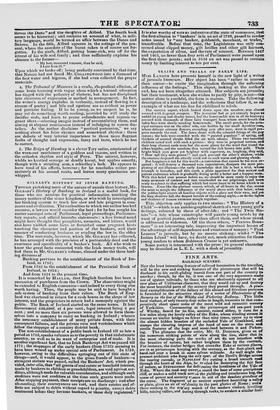FINE ARTS.
RAILROAD SCENERY.
NOT the least interesting feature of railroad locomotion to the traveller, will be the new and striking features of the picturesque that will be disclosed in his swift-gliding transit from one part of the country to another ; though, by the by, it was one of the very arguments made use of against railroads, by those who are obstinately opposed to all new plans of Utilitarian character, that they would cut up and destroy the most beautiful parts of the scenery they passed through. A prac- tical exemplification of the fallacy of this absurd and frivolous pretence is furnished in the attractive shape of a series of Illustrations of the Scenery on the line of the Whitby and Pickering Railway. This -little local viaduct, of only twenty-four miles in length, traverses in that com- paratively short space some of the most wild and romantic scenery of Yorkshire. Commencing at the picturesque old sea-port town of Whitby, famed for its fine, ancient, ruined abbey, it runs for a few miles along the lovely valley of the Eske, whose winding stream it crosses on timber bridges no fewer than nine times, opens up to view the almost hidden beauties of the secluded Vale of Goathland, and stamps the cheering impress of the hand of man on the stern and sterile features of the bogs and moor-land between it and Picker- ing. The glimpses that the artist, Mr. G. DODGSON, gives us of the numerous striking points of view along the line, show that is the most charming parts the works of art do not interfere wits the beauties of nature, but rather heighten them by the contrast. For instance, the timber bridges that cross the Eske at various places, are in as picturesque keeping with the scenery, as the foot-plank and hand-rail over a brook in some sylvan solitude. As well might the peasant architect who flung the airy spar. of the Devil's Bridge across the roaring cascade, or NAPOLEON for cutting a broad smooth road through the heart of the Alps, be re viled for destroying the fair face of nature, as SrEpuENsos for deforming the loveliness of the Vale of Eske. Where the road-way sweer,,s round the base of some precipitous cliff, or makes a solid track acres, the yielding and treacherous bog, the sense of power and security comes in aid of the desolate grandeur of the scene. The fragment Tot' an ancient aqueduct bestriding a valley or plain, gives an air of su'Jlimity to the past glories of Rome; andts there nothing in the mig'oty march of the modern viaduct, levelling hills, raising willies; and boring through rocks, to awaken a similar &ell lag ? If ever the handiworks of man are worthy to be called sublime it is when, as in the case of the Plymouth Breakwater, the Eddystone Lighthouse, or the railroad, art triumphs over the elements by wielding them according to the laws of nature. Mr. DoncsoN's sketches display great taste in their selection And treatment ; and a feeling for pictorial effect gives to these little vig- nettes a bright and sparkling appearance. He seems to have studied nature as well as the works of other artists ; though his imitations of the latter are rather too obvious, and indeed amount to mannerism. The engravings are very artistical.



























 Previous page
Previous page